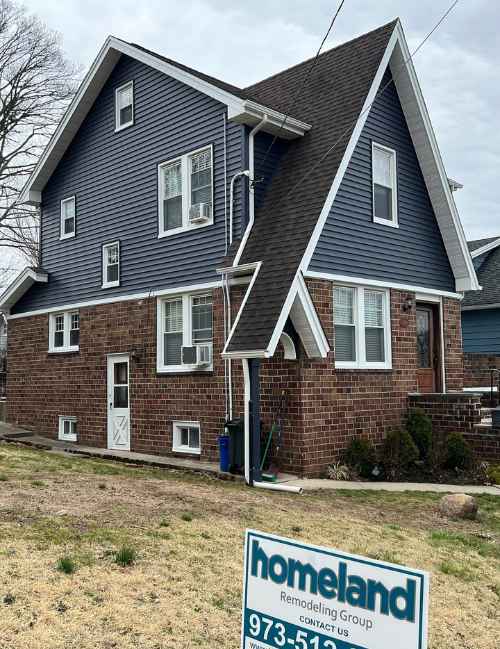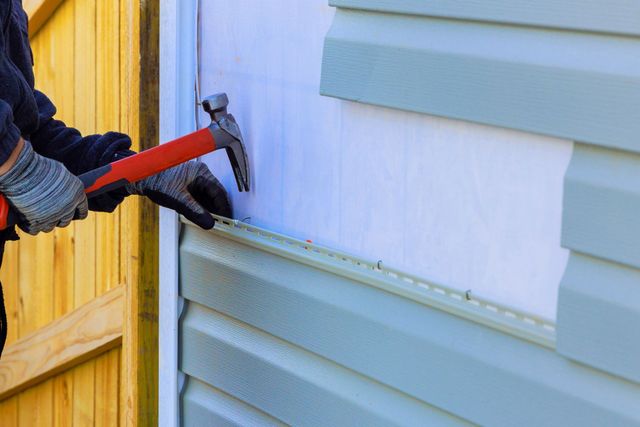The Crucial Guide to the Numerous Kinds Of House Siding and Their Distinct Advantages
In the realm of home enhancement, picking the best house siding is an important decision that affects both visual charm and practical performance. The range of products readily available, such as wood, plastic, fiber metal, block, and cement, each offer one-of-a-kind benefits that cater to various demands and choices. Comprehending these differences can dramatically boost the longevity and value of a residential or commercial property - morris siding contractor. Nonetheless, with many options to think about, which house siding product absolutely stands apart for your particular job? Checking out these options can bring about informed decisions that align with both design and practicality.
Timber House Siding
Timber home siding, a prominent choice for residential outsides, uses an ageless aesthetic that incorporates all-natural charm with structural integrity. This house siding product is offered in different styles, consisting of clapboard, tiles, and board-and-batten, enabling house owners to customize their façade to match their style preferences. Timber home siding is commonly crafted from durable species such as cedar, redwood, or yearn, which are understood for their resilience and ability to withstand environmental stress factors.
Among the main benefits of wood home siding is its excellent insulation residential properties, which can contribute to energy efficiency and lower home heating prices. In addition, timber exterior siding is biodegradable, making it an eco pleasant choice when sourced sustainably. Regular maintenance, consisting of painting or discoloration, can extend its lifespan and boost its appearance, enabling home owners to preserve the all-natural charm of the wood.
Nonetheless, potential disadvantages consist of susceptibility to bugs, rot, and weather damages, demanding sufficient therapy and upkeep - morris siding contractor. In spite of these concerns, when appropriately cared for, timber siding can supply a durable and attractive solution that boosts the personality of a home while providing a warm, inviting environment
Vinyl Siding
Plastic exterior siding has actually become a leading choice for homeowners looking for a low-maintenance exterior option that combines longevity and cost. This versatile material is crafted from polyvinyl chloride (PVC), making it immune to various weather conditions, including moisture and UV rays. Consequently, vinyl exterior siding does not warp, rot, or discolor, making certain resilient visual charm.
Among the primary advantages of vinyl exterior siding is its substantial variety of styles and shades, permitting house owners to attain the preferred seek their building without the requirement for regular repainting. Furthermore, plastic home siding is very easy to install, which can significantly decrease labor prices throughout building and construction or remodelling jobs.
Vinyl siding also adds to energy effectiveness. Several options function insulation backing, which enhances thermal performance, aiding to keep comfy interior temperatures and potentially reducing energy expenses. Its smooth surface area promotes simple cleansing, needing only regular washing with a garden hose pipe to remove dust and particles.
Fiber Cement Home Siding
Fiber concrete exterior siding has gained traction amongst house owners and contractors alike because of its amazing mix of sturdiness and aesthetic adaptability. Composed of a mix of concrete, sand, and cellulose fibers, this exterior siding option is crafted to hold up against severe weather problems, including high winds, hefty rain, and temperature level variations, making it a durable selection for household outsides.

Among the key advantages of fiber cement home siding is its resistance to bugs, such as termites, and its non-combustible nature, offering enhanced fire safety. morris siding contractor. Furthermore, it is available in a wide variety of styles, appearances, and shades, enabling property owners to achieve their desired visual without compromising efficiency
Another benefit is its reduced maintenance demands; fiber cement house siding typically requires painting or discoloration every 5-10 years, which is less frequent than other products. Additionally, its longevity adds to a reduced total cost of ownership, as it lowers the need for frequent repair services or substitutes.
Eventually, fiber concrete exterior siding stands for an excellent financial investment for those seeking a resilient, eye-catching, and flexible exterior helpful hints alternative, integrating both form and feature to improve the home's aesthetic allure.
Metal House Siding
The appeal of metal house siding hinges on its robust sturdiness and modern-day visual allure, making it a popular option for contemporary style. Readily available in materials such as light weight aluminum and steel, metal exterior siding supplies a series of colors and finishes, allowing house owners to attain a personalized appearance that enhances their design vision.

Energy effectiveness is an additional significant advantage, as lots of steel siding items are developed with insulation alternatives that aid manage indoor temperature levels. This can bring about reduced power expenses over time. In addition, metal siding is typically recyclable, making it an eco pleasant choice for sustainability-minded home owners.
The installment process for steel house siding can be fairly simple, leading to a quicker turn-around time for building projects. Generally, steel siding combines performance and style, making it a useful option for those seeking a enduring and visually enticing exterior coating.
Brick and Stone House Siding
Block and rock home siding stands apart as an ageless option that improves the visual charm of any home. Understood for find more information their sturdiness and low upkeep, these products provide an outstanding roi while elevating the home's curb charm. Offered in various colors, textures, and patterns, brick and rock can be tailored to fit varied building designs, from typical to modern.
One of the key advantages of block and stone siding is their power performance. Both materials possess natural protecting homes that assist control interior temperature levels, potentially minimizing heating & cooling costs. Furthermore, they supply superior fire resistance compared to other home siding alternatives, adding to enhanced security.
An additional benefit is their long life. Brick and rock can last for years, often requiring very little upkeep beyond periodic cleansing. Unlike timber house siding, they are unsusceptible pests and rot, guaranteeing a resilient outside that stands up to the components.
Verdict
In recap, the option of siding significantly impacts a home's aesthetic appeal, power efficiency, and upkeep needs. Each kind of house siding-- whether timber, plastic, fiber block, steel, or cement and stone-- offers unique advantages customized to different house owner preferences and environmental conditions. Recognizing these helpful resources alternatives allows notified decisions that enhance both the sturdiness and visual charm of household outsides. Inevitably, picking the appropriate house siding is essential for attaining an equilibrium in between functionality and style in household style.
One of the primary advantages of timber exterior siding is its excellent insulation properties, which can add to energy efficiency and reduced heating prices. Additionally, timber siding is eco-friendly, making it an ecologically friendly choice when sourced sustainably.One of the main benefits of steel exterior siding is its resistance to various ecological aspects.Power performance is one more substantial benefit, as numerous steel house siding products are developed with insulation choices that aid regulate indoor temperatures. Each type of home siding-- whether timber, plastic, fiber brick, metal, or cement and stone-- uses special advantages customized to various property owner preferences and environmental conditions.